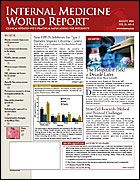Publication
Article
Internal Medicine World Report
Avian Flu Hits Young People Hardest
Author(s):
Experts Suggest 1918 Pandemic a Model for Future Outbreak
JP Garnier, PhD
Weekly Epidemiological
Record
Avian influenza A (H5N1) strikes young people the hardest, according to new data published in the World Health Organization's (WHO) (2006;81:249-260), which show the highest case-fatality rates are in those aged 10 to 19 years.
This analysis, which included the 203 laboratory-confirmed human cases of H5N1 infection reported by date of onset to the WHO from December 2003 through April 2006, showed 3 peaks of infection during the study period that more or less corresponded to winter and spring in the northern hemisphere.
These data demonstrate a pattern that could mean an upsurge in cases starting in late 2006 or early 2007, the report states. Additional studies are needed to determine the relationship between climate conditions and H5N1 infection outbreaks.
To date, the highest number of cases have occurred in patients aged 10 to 29 years. The overall case-fatality rate was 56%, with the highest rate (73%; n = 49) occurring in those aged 10 to 19 years and the lowest rate (18%; n = 11) in those aged >50 years.
"This age profile differs from seasonal influenza, where the highest mortality rates are found among the very old age. The difference in the age-related case-fatality distribution among H5N1 cases is reminiscent of that observed during the previous influenza pandemics, particularly in 1918, where case-fatality rates were higher among young adults," the report suggests.
Ann Intern Med
Lessons learned from the 1918 influenza pandemic should be the basis for planning the response to future avian pandemics, says John G. Bartlett, MD, Infectious Diseases, Johns Hopkins University School of Medicine, Baltimore, in a recent editorial (. 2006 Jun 26; online ahead of print). Despite access to modern intensive care, the mortality rate for H5N1 is reported to be about 20-fold higher than in the 1918 pandemic, he notes.
The US challenge is how to develop a coordinated plan for a fragmented healthcare system, Dr Bartlett observes. Given that a pandemic would quickly overwhelm bed capacity at hospitals, planning must start now. "Healthcare personnel issues are particularly important," he noted, as an avian flu pandemic may necessitate efficient ways of credentialing and providing liability protection for personnel from other states or recalled from retirement.
The Physician's Role
In response to the recent Health and Human Services' (HHS') report, "HHS Pandemic Influenza Plan," the American College of Physicians (ACP) issued policy positions to discuss the role of physicians in this effort. The ACP positions call for:
? The development of local public health task forces that include physicians representing all specialties and practice settings
? Physician access to 2-way communication with public health authorities and to information technology tools for diagnosis and syndrome surveillance
? Clear identification and authorization of agencies to process the licensing and registration of volunteer physicians
? Clear guidelines for overriding standard procedures for confidentiality and consent in the interest of the public's health
? Clear and fair infection control measures that do not create barriers to care
? Analysis of and solutions for current problems with seasonal influenza vaccination programs to develop a maximally efficient pandemic flu vaccine program.
According to the ACP, 2 aspects of the HHS plan are of particular concern to physicians.
First, in the event of an avian pandemic, healthcare will probably need to be rationed, but the college points out that the HHS does not give any directives on how this will be achieved and calls for the agency to provide "clear guidance and involvement of federal authorities" to educate the public.
Second, the ACP points out that the HHS has failed to thoroughly incorporate the leading role physicians must play in the community setting. (Read the entire report at www.acponline.org/college/pressroom/as06/pandemic-policy.pdf)
Vaccine Update
GlaxoSmithKline has released promising data about its investigational H5N1 flu vaccine, showing that the vaccine achieved a high immune response at a low dose of antigen. The vaccine, which uses a proprietary adjuvant, enabled >80% of patients who received 3.8 ?g of antigen to demonstrate a strong seroprotective immune response. This level of seroprotection meets or exceeds target criteria set by regulatory agencies for registration of influenza vaccines.
"This is the first time such a low dose of H5N1 antigen has been able to stimulate this level of strong immune response," said JP Garnier, PhD, chief executive officer for GlaxoSmithKline. "We expect to make regulatory filings for the vaccine in the coming months."
The new results are based on an interim analysis of a clinical trial with 400 healthy adults (aged 18-60 years) who each received 2 vaccinations during the course of the trial and 4 different levels of antigen dose, with 3.8 ?g being the lowest dose assessed.
Changes to Varicella Vaccination Schedule
The Advisory Committee on Immunization Practices (ACIP) to the Centers for Disease Control and Prevention has recommended a second dose of varicella vaccine for children aged 4 to 6 years to give them additional protection against the disease.
The first dose should be administered at age 12 to 15 months. The second dose is being recommended because 15% to 20% of children who have received the first dose of the vaccine are not fully protected and may develop chickenpox after coming into contact with the varicella zoster virus. In addition, a single dose may not provide continued protection into adulthood when chickenpox is more severe.
The ACIP is also recommending a second dose for older children, adolescents, and adults who have received only 1 dose of the vaccine.






